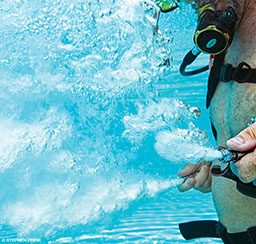The Diver
The diver was a 24-year-old woman who was first certified to dive the previous year. She was 5 feet 4 inches tall, weighed 140 pounds and had a body mass index (BMI) of 24. Since her certification she had made a total of 50 dives, 30 of those during the preceding 12 months, and had dived to a maximum depth of 130 feet.
The Incident
The diver was part of a group that was visiting a local inland dive site. Soon after she entered the water but before she descended, her octopus hose (alternate second-stage hose) started flying around wildly, slapping the water and making a loud free-flowing sound. She did not initially know what was happening and attempted to grasp the hose. The diver’s buddy turned off her tank valve, and the hose went limp. This all happened in chest-deep water at the surface while the divers were putting on their fins before the dive. On close inspection the diver discovered that the plastic octopus regulator had completely broken away from the hose. The regulator second stage fell to the bottom, and the hose was left in a free-flowing state. Thankfully no one was hurt, but the diver reported that the incident was a bit scary because it was so unexpected.
Analysis
The cause of this incident was a plastic second-stage octopus regulator breaking away under pressure. In most regulators the metal fitting at the end of the hose is attached to a metal part of the second stage that contains the valve that opens to provide air when the diver inhales. In this case the attachment point was also plastic, and it gave way under the pressure in the hose.

This diver and her companions are lucky no one was harmed. It was also fortunate the regulator did not detach itself underwater while the diver was at depth. Experiments have shown that a tank will empty far more quickly if a low-pressure hose (regulator or inflator hose) bursts than if a high-pressure hose (pressure-gauge hose) bursts. This is because the low-pressure hose has a much larger hole for the air to pass through where it screws into the first-stage regulator. The difference can be as substantial as the tank emptying in less than one minute when a low-pressure hose bursts, compared with taking more than 10 minutes if a high-pressure hose bursts. All divers should regularly inspect their hoses for wear and tear, especially every time regulators are rented or borrowed.
In this incident, however, the hose was not the component that failed under pressure — it was the second-stage regulator (though the net effect was the same as if the low-pressure hose had burst). In speaking with scuba equipment experts, DAN® Research discovered that this particular type of second-stage regulator has not been manufactured for many years. This could be a clue as to why it failed on this occasion. DAN located a similar second stage to the one this diver was using, and under a magnifying glass microcracks could clearly be seen around the port to which the low-pressure hose attaches.
It seems the diver was using an older second stage as her octopus, and despite regular servicing the plastic had started to deteriorate — microcracks may have formed where the hose attached. These can be hard to spot without very careful inspection. Because this incident highlights a potential point of failure, and because that failure can empty a tank in less than a minute, regardless of depth, DAN urges all divers with older second stages to have them inspected for microcracks in the plastic.
Fortunately no one was injured during this alarming incident; the octopus and hose were swapped out, and the divers went diving. Also fortunately, the diver’s buddy was wearing a video camera on his head at the time and captured the whole event. All of the divers involved gave permission for this video clip to be posted on the DAN website in the Incident Reports section at DAN.org/incidents.
We thank the diver for sharing this important incident. This may well prevent it from happening to another diver. We encourage any diver who experiences an unplanned event during a dive to file a dive incident report through the DAN website.
| © Alert Diver — Q2 2017 |